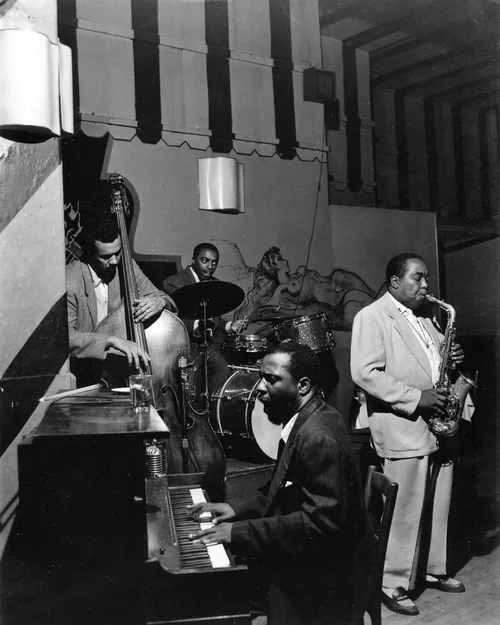What is a Jazz Combo?
Jazz music is a rich tapestry woven with improvisation, syncopation, and an infectious energy that captivates listeners worldwide. Central to the jazz tradition is the ensemble, a group of musicians collaborating in real-time to create vibrant, spontaneous music. Among the various formations within jazz ensembles, one stands out for its intimacy, flexibility, and creative potential: the jazz combo. In this blog, we'll delve into what exactly a jazz combo is, its historical roots, typical instrumentation, roles of its members, and its significance in the broader landscape of jazz music.

To understand the essence of a jazz combo, it's essential to trace its roots back to the early 20th century when jazz emerged as a distinctive musical form in the melting pot of African American communities in New Orleans. In these settings, musicians would gather in informal jam sessions, experimenting with blending European harmonies and African rhythms. These gatherings often involved small groups of players, laying the groundwork for what would later become the jazz combo.
What is a Jazz Combo?
A jazz combo is a small jazz band, consisting of 3 to 5 members. Typically composed of a drummer, bassist, pianist and a guitarist or horn player.
A jazz combo typically consists of a small group of musicians, ranging from three to eight members, though the exact number can vary. Unlike larger jazz ensembles such as big bands, combos offer a more intimate setting where each musician has greater freedom for improvisation and expression. The core instrumentation of a jazz combo typically includes a rhythm section comprising drums, double bass or electric bass, piano or guitar, and a horn section featuring instruments like saxophones, trumpets, or trombones.
Within a jazz combo, each member plays a vital role in shaping the collective sound. The rhythm section lays down the harmonic and rhythmic foundation, providing the framework upon which melodies and improvisations can flourish. The drummer sets the groove and tempo, while the bassist establishes the harmonic structure and provides a solid anchor for the ensemble. The pianist or guitarist adds harmonic textures and often takes on a dual role as a soloist. Meanwhile, the horn players contribute melodies, solos, and improvisational flair, engaging in dynamic interplay with each other and the rhythm section.
At the heart of the jazz combo is the spirit of improvisation – the spontaneous creation of music in the moment. Improvisation lies at the core of jazz, allowing musicians to express themselves freely and engage in musical dialogue with their fellow players. In a combo setting, improvisation takes center stage, with each member taking turns to solo over the underlying chord changes. This exchange of ideas and melodies fosters a sense of camaraderie and shared musical exploration, making each performance unique and unpredictable.
If you are interested in learning music check out our Music Lessons in Tempe.
Jazz combos are incredibly versatile, capable of tackling a wide range of musical styles and genres. Their repertoire may encompass classic jazz standards, bebop tunes, blues, Latin jazz, funk, or even contemporary compositions. Moreover, jazz combos are well-suited to various performance settings, from intimate club gigs and jam sessions to formal concerts, festivals, and private events. Their adaptability and compact size make them ideal for navigating diverse venues and engaging with audiences on a personal level.
Beyond their role in live performance, jazz combos also serve as invaluable educational tools for aspiring musicians. In academic settings, jazz combos offer students hands-on experience in ensemble playing, improvisation, and musical communication. Through rehearsals and performances, students learn not only the technical aspects of their instruments but also the importance of listening, collaboration, and adaptability – skills that are transferable to various aspects of life.
The legacy of jazz combos extends far beyond the realm of music. Throughout history, jazz has been a vehicle for social change, promoting cultural exchange, breaking down racial barriers, and fostering a sense of unity and community. Jazz combos, in particular, embody this spirit of inclusivity and innovation, bringing together musicians from diverse backgrounds to create something greater than the sum of its parts. As ambassadors of creativity and freedom, jazz combos continue to inspire and influence audiences around the world.
In summary, a jazz combo is more than just a musical ensemble – it's a living, breathing embodiment of the improvisational spirit and collaborative ethos that define jazz music. Through their intimate settings, dynamic interplay, and boundless creativity, jazz combos continue to captivate listeners and push the boundaries of artistic expression. Whether performing in smoky clubs or prestigious concert halls, these small but mighty ensembles remind us of the power of music to transcend boundaries and unite people across cultures and generations. So, the next time you encounter a jazz combo, sit back, relax, and let yourself be swept away by the magic of spontaneous musical dialogue.
If you like this check out our article: Why Do Jazz Musicians Wear Suits?
